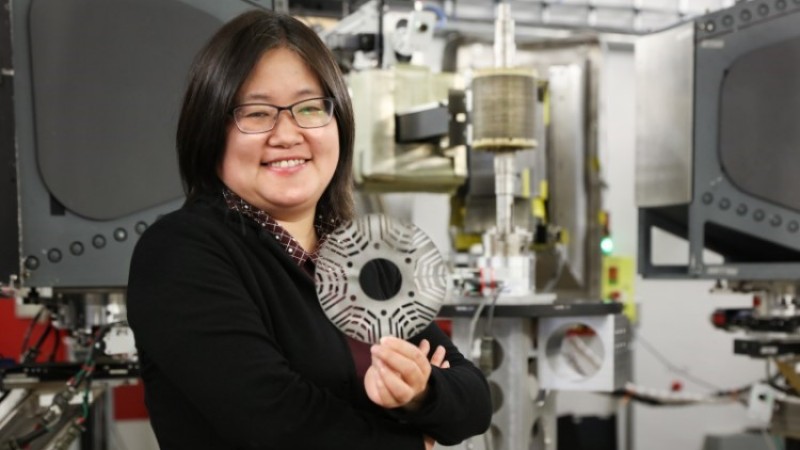
Electric motors might be better described as "magnetic motors." That's because the electricity supplied to them, typically from a battery or power grid, is used to control a series of magnets-and it's the magnetic forces that do most of the work of producing the motor's power output.
Now scientists from GE Research, in collaboration with researchers at the Department of Energy's (DOE's) Oak Ridge National Laboratory (ORNL), have developed and characterized a new type of "magnetic motor." GE's unique design features a soft magnetic steel material capable of having its magnetism controlled at the millimeter scale in virtually any pattern, which permits higher power densities and efficiencies than electric motors made from conventional silicon steel.
By combining ceramic masks and gas nitrogenation (treating the alloy with nitrogen), GE can meet design requirements by controlling the material's level of magnetization from zero to 100 percent at every position, without removing any of the material itself. Non-magnetic areas can be positioned to provide enhanced mechanical strength for high-speed applications.
Most electric motors operate on the basic principle that when a current- carrying conductor is placed in a magnetic field, this generates force, or torque, which can be used to turn a shaft. The two primary motor components are a stationary cylinder, or stator, and a rotating drum, or rotor, with a small gap between them.
The electric motor generates torque by alternating the electric current-and therefore, the magnetic field-of the electromagnets arranged around the inside of the stator. As the rotor turns, its negatively charged electromagnets are pulled toward their positively charged counterparts in the stator. The instant they align, the polarity of the stator electromagnets is changed to negative, causing the negatively charged rotor electromagnets to now be repulsed, which keeps the rotor turning in the desired direction. This pull-push cycle is repeated at high speed to keep the rotor turning and to generate sufficient torque to power a vehicle or other mechanical device.
"Conventional high-performance electric motors require permanent magnets made of expensive rare-earth materials, plus their rotors are usually made of magnetic laminates that cause energy loss due to the high magnetization in the mechanical supportive locations, thus reducing the desired magnetic interaction between the stator and rotor," said Min Zou, project leader for the GE program. "Our unique synchronous reluctance motor design helps reduce costs by eliminating the use of rare-earth permanent magnets, and our ability to pattern the magnetic and non-magnetic areas of a rotor optimizes the magnetic circuit, so the rotor can turn more efficiently and with greater power."
The GE prototype rotor consists of a stack of hundreds of individual sheets of the magnetic material, called laminates, which are nitrogenated at high temperature after having a ceramic mask applied to control the spread of nitrogen in the desired pattern. The masked regions remain magnetic, while the exposed regions transform to non-magnetic. The masks are removed prior to assembling the laminates into the rotor stack.
GE originally approached ORNL's Physical Sciences Division for technical assistance in evaluating the effects of the high-heat nitrogenating process on the soft magnetic material.
PSD researchers Craig Bridges, Mike Brady and Orlando Rios, with postdoctoral research associate Hunter Henderson, worked with GE's scientists to develop a processing method to produce the magnetic alloy in rolled sheets as thin as one-hundredth of an inch. They also helped create a unique process used to define the areas that have their magnetism turned off, as well as chemical and mechanical methods of removing the masks.
Once the laminate production process was established, GE wanted to examine the prototype laminates for signs of warping and internal residual stress (resulting from internal distortions during processing), which could weaken the material. Since part of the magnetic patterns are buried deep inside the stack of metal laminates, neutrons were the best solution because of their highly penetrating properties.
"We conducted the residual stress analysis experiments at Vulcan, the world's premier neutron instrument for studying phase and residual stress distribution in large industrial samples," said Ke An, neutron scattering scientist at ORNL's Spallation Neutron Source (SNS). "Unlike x-rays, neutrons are able to penetrate deeply into metals and Vulcan was able to produce data on the residual stresses of different phases of the laminates inside the stack."
The results of the residual stress analysis at the SNS will be used to establish design rules to avoid warping and to minimize distortion during the nitrogenation of the rotor laminates.
The experimental results indicate there are significant residual stresses that are not uniformly distributed, which agrees with the calculated stress distribution conducted by GE mechanical engineers. Actual measured residual stress data will help with future laminate designs to reduce warpage and maintain mechanical integrity.
This material is based upon work supported by the Department of Energy, Office of Energy Efficiency and Renewable Energy (EERE), under Award Number DE-EE0007755. Other support was provided through the DOE Office of Science.






